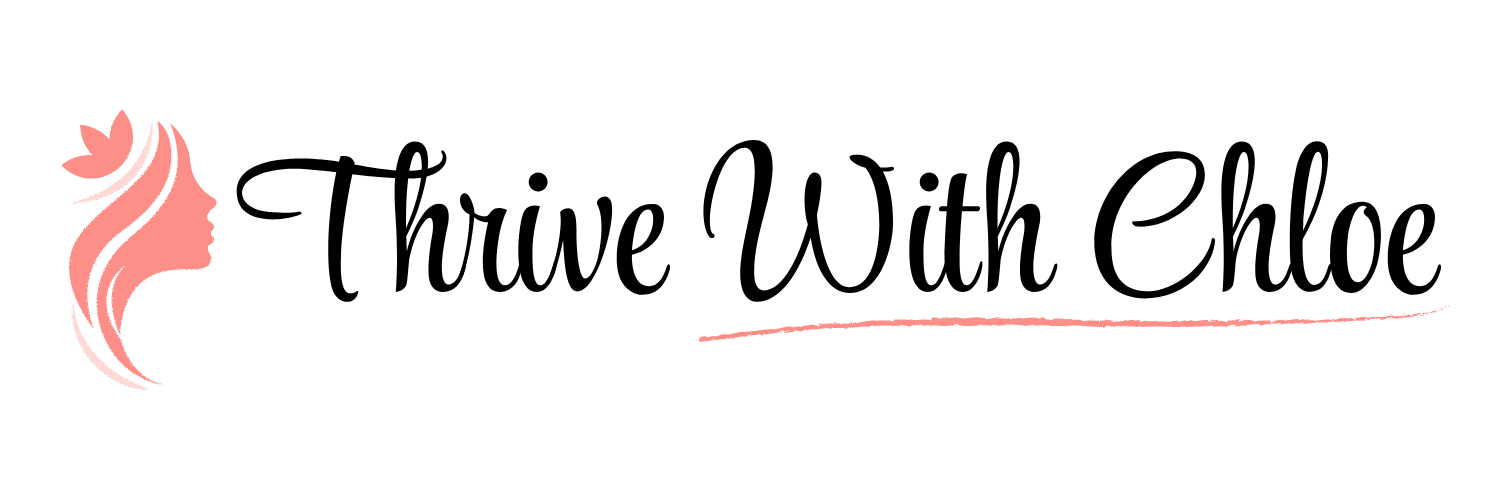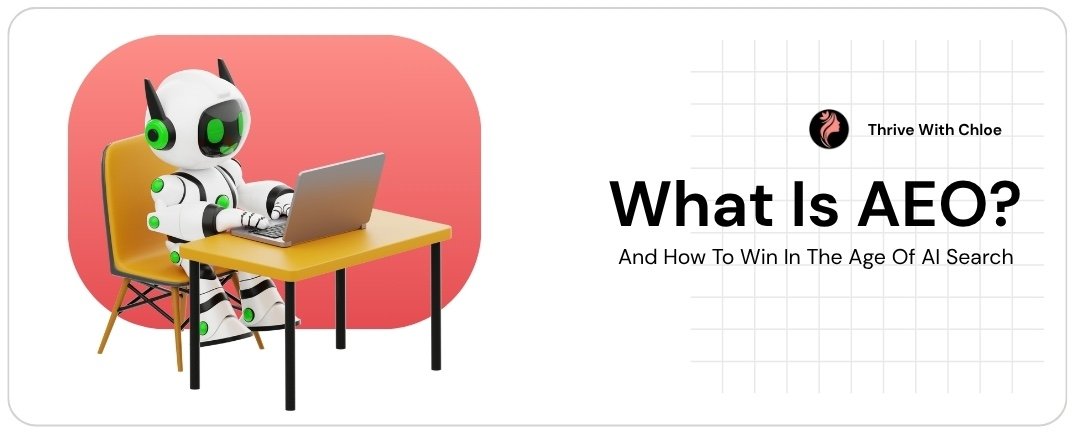The way people search online is changing fast. Google is now integrating AI into its results through features like AI Overviews and the Search Generative Experience (SGE). This shift means SEO is no longer just about ranking for blue links — it’s about ensuring your content is visible and useful within AI-powered search experiences.
That’s where AI SEO (AI Search Optimisation) comes in. It’s the practice of adapting traditional SEO strategies to align with Google’s AI-driven search updates — focusing on clarity, structure, and authority so your content gets surfaced in AI-powered results.
But what is AI SEO exactly, and how does it differ from traditional SEO? In this guide, we’ll break down the essentials, from its definition to the core strategies you need to stay visible as Google continues to evolve.
Key Takeaways
- AI SEO (AI Search Optimisation) is the practice of adapting your content for Google’s AI-driven features, such as AI Overviews and SGE.
- It focuses on clarity, authority, and structured content so Google’s AI systems can surface your pages in enhanced search results.
- Unlike traditional SEO, which prioritises keywords and backlinks, AI SEO places greater emphasis on topical authority, semantic optimisation, and machine-readable structure.
- Core SEO foundations (titles, meta descriptions, alt text, page speed) remain important, but they must be combined with AI-focused strategies to stay competitive.
- Businesses and creators who embrace AI SEO early will gain a significant edge as Google continues reshaping how search results are generated and displayed.
What is AI SEO?
AI SEO (AI Search Optimisation) is the practice of optimising your content for Google’s AI-powered search features, such as AI Overviews and the Search Generative Experience (SGE).
Unlike traditional SEO, which is built around keywords, backlinks, and ranking positions, AI SEO focuses on making your content clear, contextually relevant, and authoritative so Google’s AI systems can surface it within enhanced search results.
Core Elements of AI SEO (Key Pillars)
Content Quality & Authority
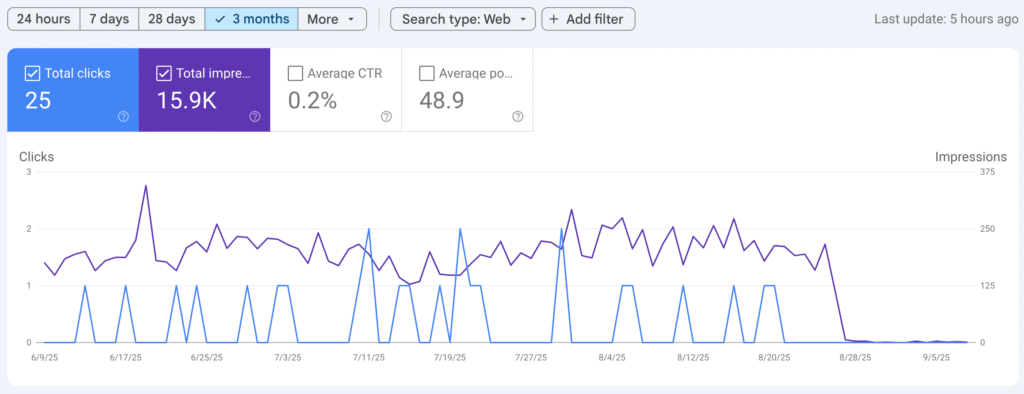
When it comes to AI SEO, the first and most important factor is content quality. Search engines and AI models alike are designed to surface content that is helpful, authoritative, and trustworthy.
This was made especially clear after Google’s Helpful Content Update, which hit many websites that had relied on mass-produced AI articles without adding real value.
Sites that churned out thin, repetitive, or poorly edited AI content saw significant drops in traffic, while websites offering expert-driven, well-edited content remained strong or even improved in visibility.
This update underlines a key truth: AI tools are fantastic assistants, but humans must lead the way.
- AI tools can speed up research, help generate outlines, and even provide first drafts.
- But humans are the ones who add expertise, context, tone, and the “human touch” that both Google and readers value.
Simply put: using AI alone isn’t always enough. You need to have a level of subject knowledge to guide the tools, spot inaccuracies, and polish the final content so it resonates with people, and gets rewarded by search engines.
At Thrive With Chloe, this balance is at the heart of my process. I leverage AI to make the writing process faster and more efficient, but every piece is carefully edited and finalised by hand.
That ensures my clients get content that’s not only optimised for search and AI engines but also genuinely valuable and human-centred.
Entity & Semantic Optimization
In AI SEO, keywords alone aren’t enough. Google’s AI systems don’t just scan for repeated words — they look for entities (people, brands, places, and concepts) and how they relate to each other. This helps the AI decide whether your content truly covers a topic in depth.
Take an article on “How to Train a Puppy”
Of course, you’ll naturally mention the word puppy a few times. But what really makes the content strong is including connected entities like:
- Breeds (Labrador, Beagle, German Shepherd)
- Concepts (positive reinforcement, potty training, leash training)
- Tools (treats, clickers, puppy pads)
- Places (vet, dog park, training classes)
By weaving in these related pieces, you’re not just saying “puppy” — you’re showing that you understand everything around the topic.
That’s what semantic optimisation means: building context, not just repeating words. By covering the surrounding entities, you’re signalling to Google’s AI that your content is authoritative, complete, and the best candidate to appear in AI Overviews or summaries.
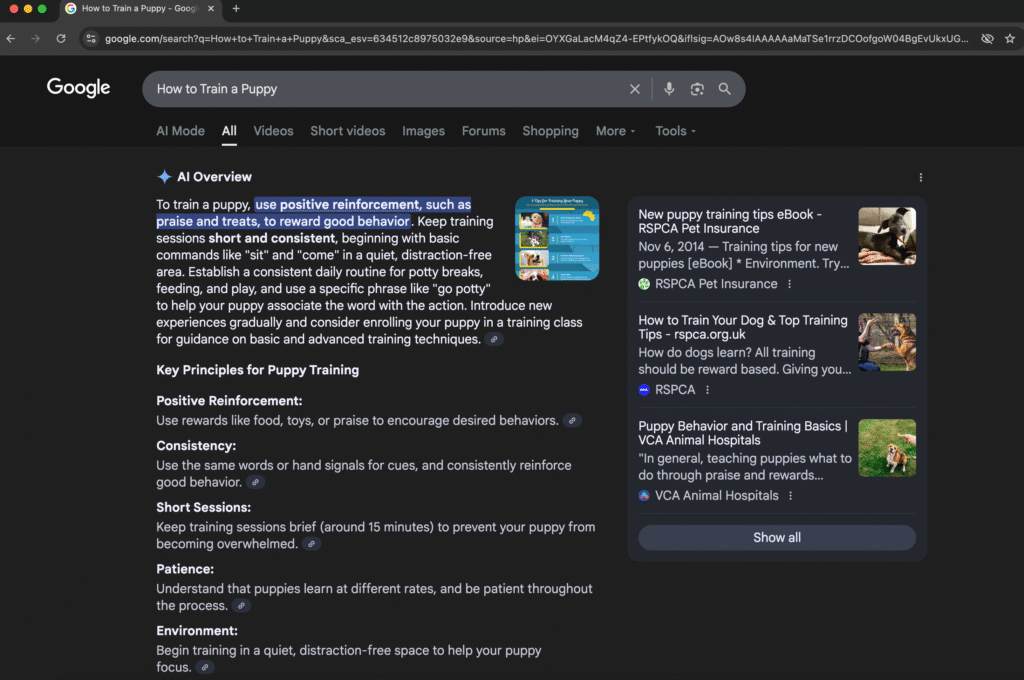
Best practices for semantic optimisation:
- Use natural language and answer questions the way people ask them.
- Include related terms and entities (use tools like Google’s “People Also Ask,” or AI keyword tools).
- Write for clarity and context, explain not just “what,” but also “why” and “how.”
This approach makes your content more likely to be cited by AI-powered search engines, which are built on understanding meaning, not just keywords.
Content Clusters & Topical Authority
While semantic optimisation strengthens individual articles, content clusters establish authority across your site. After 2024, clustering became one of the strongest signals for ranking — sites with well-structured clusters consistently outperformed those with scattered, unlinked posts.
A content cluster starts with a pillar article on a broad topic and links to supporting posts on related subtopics. This signals to Google’s AI systems that your site has depth and authority on the subject.
Example cluster:
- Pillar: “Complete Guide to AI SEO”
- Supporting articles:
- “What is AI SEO?” (this article)
- “How to Use AI for SEO”
- “AI SEO vs Traditional SEO”
Best practices for building topical authority:
- Map keywords into groups, starting with one core topic.
- Create one comprehensive pillar article that links to related posts.
- Interlink consistently between pillar and supporting content.
- Cover topics in depth to answer all related questions.
- Update regularly to keep clusters fresh and relevant.
Pro tip: Start small. Build one strong cluster (pillar + 3–5 posts), then expand outward. Quality and depth beat scattershot coverage.
Structured Data & Schema
Another core pillar of AI SEO is structured data, typically implemented through schema markup. Schema helps Google’s AI better interpret your content and decide how to display it.
In traditional SEO, schema supports rich results like star ratings or FAQ dropdowns. In AI SEO, it also improves your chances of being summarised or featured in AI Overviews, since it gives Google machine-readable signals about your content.
Examples:
- Recipe schema → Ingredients and steps may appear in AI summaries.
- FAQ schema → Common questions can be surfaced directly in AI Overviews.
- Product schema → Details like price or reviews can appear in search features.
Best practices for schema:
- Add FAQ schema to capture long-tail and conversational queries.
- Use How-to schema for step-based guides.
- Implement Product/Review schema for e-commerce or affiliate content.
- Validate schema with Google’s Rich Results Test.
- Keep markup updated — broken or outdated schema hurts visibility.
The goal isn’t to game Google but to make your content machine-readable. By doing so, you increase your chances of being highlighted in AI-driven search results.
User Intent Alignment
At the heart of SEO — and especially AI SEO — is user intent. Whether someone types a phrase into Google or interacts with its AI tools, they’re looking for a specific type of answer. If your content doesn’t align with that intent, it won’t be surfaced.
Three main intent types:
- Informational → Learn something (“What is AI SEO?”)
- Navigational → Find a brand or site (“Thrive With Chloe SEO services”)
- Transactional/Commercial → Buy or compare (“Best AI SEO tools 2025”)
Why intent matters more in AI search:
Google’s AI aims to generate direct, conversational answers. If your content doesn’t fully match the query format, it won’t be selected. For example:
- “How to use AI for SEO” → Needs step-by-step strategies, not definitions.
- “AI SEO tools” → Needs comparisons, pros/cons, and recommendations.
How to identify intent:
- Put yourself in the searcher’s shoes → What would you want for this query?
- Check the SERPs → Are top results blog posts, product pages, or brand sites?
- Look at People Also Ask → Reveals secondary questions to cover.
- Use AI-powered keyword tools → Many now group queries by intent type.
Best practices for aligning with intent:
- Answer the primary intent clearly in the introduction or Key Takeaways.
- Cover secondary intents in subheadings (H2/H3s).
- Match format to intent: guides for informational, comparisons for commercial, service pages for navigational.
- Use conversational tone and FAQs with schema to capture natural queries.
- Update content regularly — intent can shift as markets and search evolve.
Traditional SEO Practices That Still Matter
With all the excitement around AI search, it’s easy to assume that traditional SEO is dead, but that couldn’t be further from the truth.
The truth is, AI SEO builds on top of traditional SEO foundations, not instead of them. Google, Bing, and AI search engines still rely on structured, accessible, and well-optimised websites to deliver reliable results.
Neglecting the basics can undo all the progress you make with advanced AI strategies.
Here are the traditional practices that remain essential:
1. On-Page SEO Basics
- Title tags and meta descriptions: Still vital for click-through rates on Google and for giving AI engines clear summaries of your content. Always include your main keyword naturally.
- Header tags (H1, H2, H3): Proper use of headings not only improves readability but also helps search engines and AI systems understand your content hierarchy.
- Keyword density: Keywords shouldn’t be stuffed but should appear naturally in the introduction, headers, and throughout the text.
💡 Best practice: Optimise for humans first, search engines second. Write clear titles that answer search queries directly, then refine with your primary keyword.
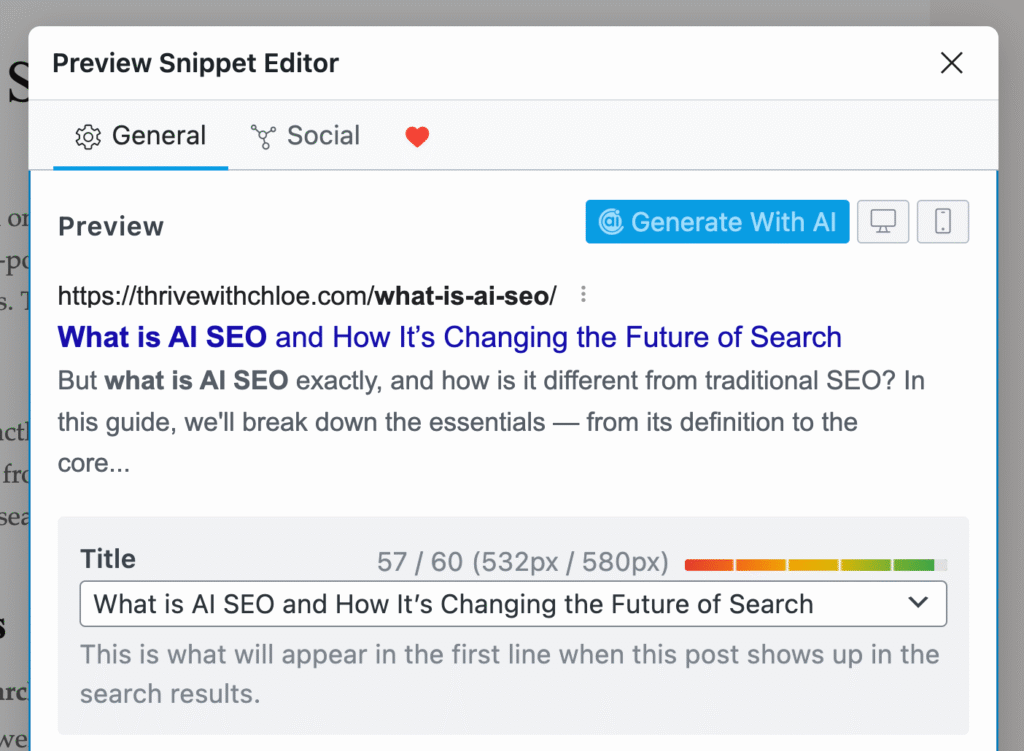
Here’s a ready-to-use ChatGPT prompt you can copy for generating SEO titles and meta descriptions: Write an SEO meta description (maximum 160 characters) for an article about “[Insert Keyword/Topic]”. Start with a question, use natural human voice, include the exact keyword, make it compelling with a strong CTA. Then write an SEO title (maximum 60 characters), [your choice of tone of voice].
2. Image Optimisation
Images can either boost your SEO or weigh it down. Proper optimisation ensures they contribute to rankings and user experience.
- Alt text: Add descriptive alternative text for every image. Not only does this improve accessibility, but it also signals relevance to search engines and AI.
- File names: Don’t upload “IMG_1234.jpg.” Instead, rename files descriptively (e.g., ai-seo-diagram.jpg).
- Compression: Use tools to reduce file size without losing quality to improve page speed.
💡 Best practice: Treat image optimisation as both an SEO requirement and a user experience improvement.
Here are some of the best tools I recommend for compressing images and converting file formats:
3. Technical SEO
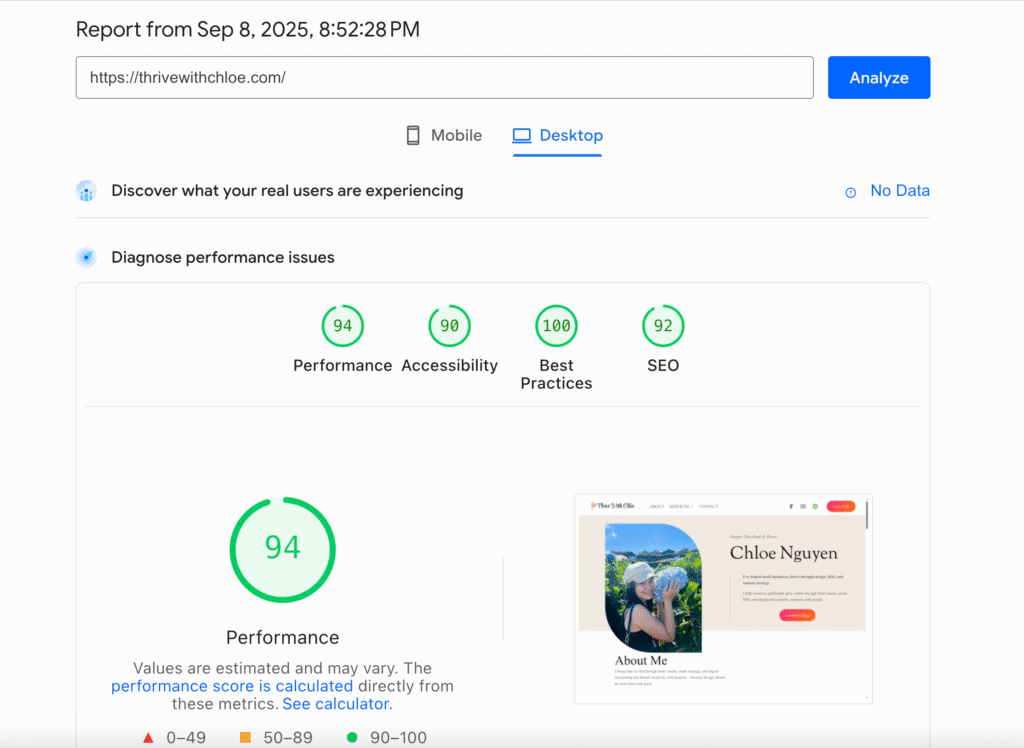
A fast, functional, and crawlable website is non-negotiable. Even the best AI-optimised content won’t perform if your site’s technical health is poor.
- Mobile-first design: With most searches happening on mobile, a responsive design is mandatory.
- Page speed: Compress images, reduce scripts, and use caching to improve load times. You can check the page speed by using pagespeed.web.dev
- Crawlability and indexing: Ensure your site structure, robots.txt, and sitemap are properly configured.
- HTTPS security: Secure websites (SSL certificates) are still a ranking factor.
💡 Best practice: Run regular site audits (Google Search Console, Ahrefs, or Screaming Frog) to catch technical issues early.
4. Internal Linking Strategies
Internal links remain one of the most powerful, and underused, traditional SEO tactics. They improve navigation, distribute link equity, and strengthen topical authority.
- Link contextually: Place links where they make sense in the flow of the content.
- Use descriptive anchor text: Instead of “click here,” use meaningful phrases (e.g., learn more about AI SEO tools).
- Cluster reinforcement: Link supporting posts back to pillar pages and vice versa.
💡 Best practice: Aim for 3–5 internal links per 1,000 words, balancing reader experience with SEO structure.
My go-to internal linking tools:
5. Content Freshness and Updates
Search engines and AI tools favour content that’s current and relevant. Outdated posts risk being ignored or replaced by fresher, more authoritative content.
- Update statistics, screenshots, and examples regularly.
- Refresh older articles with new insights to maintain rankings.
- Re-optimise headings and metadata as user intent evolves.
💡 Best practice: Audit your content quarterly. Even small updates can help sustain traffic and visibility.
AI SEO vs Traditional SEO
While traditional SEO and AI SEO share the same foundation — making your content visible in Google — the way they achieve it is evolving.
Traditional SEO is about ranking pages in the search results, whereas AI SEO adapts to Google’s AI-powered features like AI Overviews and the Search Generative Experience (SGE).
Traditional SEO
- Keywords & backlinks: Ranking signals are built around keyword optimisation, link-building, and technical health.
- Page-based visibility: The goal is to land in the top 10 blue links on Google.
- Content format: Long-form blog posts, optimised landing pages, and metadata for click-throughs.
- Metrics: Rankings, organic traffic, CTR, and bounce rate.
AI SEO
- Entities & context: Optimisation focuses on semantic depth, entities, and relationships between topics.
- Answer-based visibility: The goal is to appear within Google’s AI Overviews or enhanced snippets.
- Content format: Clear definitions, FAQs, step-by-step guides — structures Google’s AI can summarise easily.
- Metrics: Presence in AI Overviews, visibility in featured snippets, and topical authority signals.
AI SEO doesn’t replace traditional SEO — it extends it. You still need the basics (titles, alt text, backlinks, site speed), but you also need to structure your content for Google’s AI-driven ecosystem. By combining both, you ensure visibility in classic rankings and in AI-powered search results.
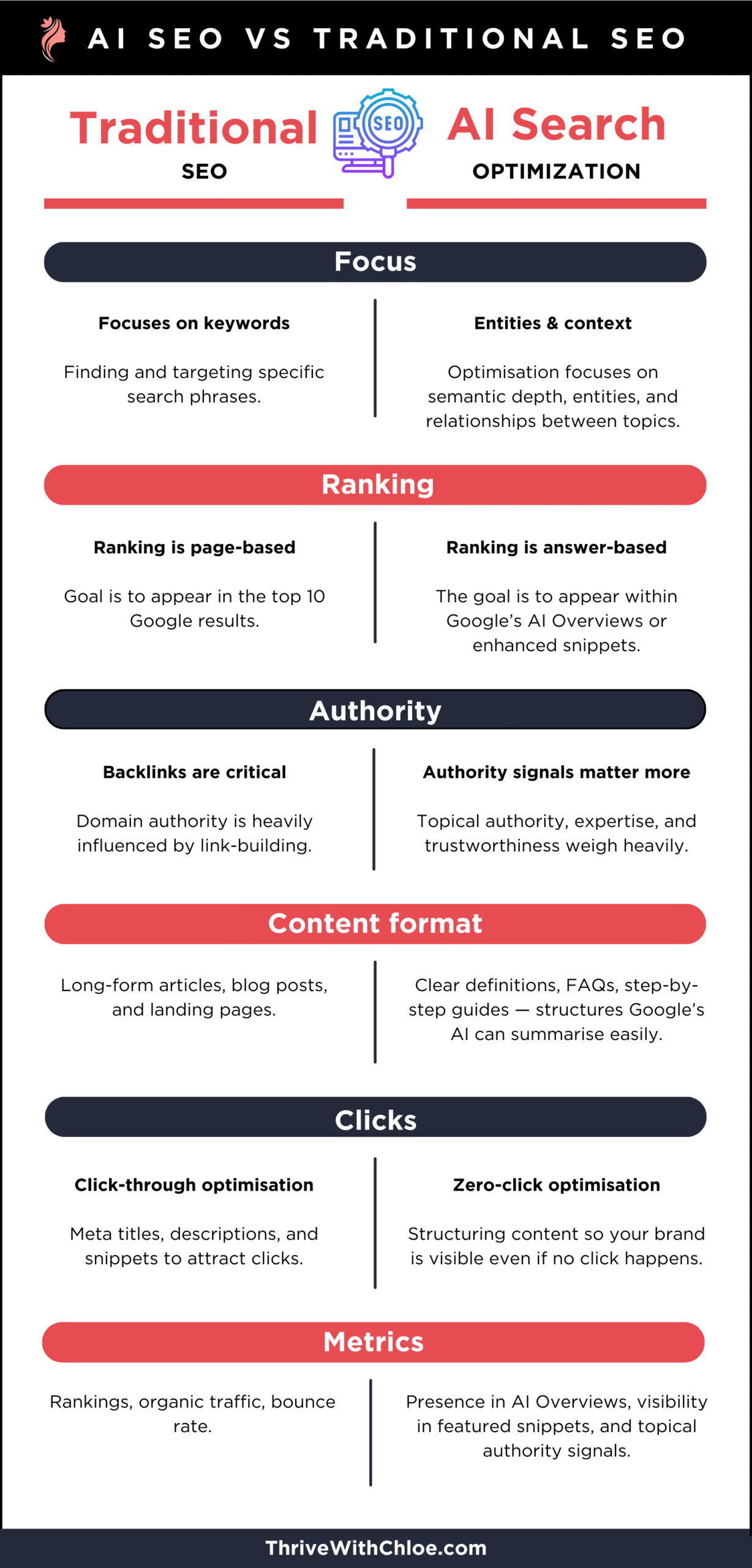
Practical AI SEO Strategies You Can Use Now
Now that we’ve covered the foundations, let’s look at practical ways to apply AI SEO today. These strategies focus on preparing your content for Google’s AI-driven features like AI Overviews and SGE.
- Answer Questions Directly and Clearly
Google’s AI features highlight concise answers. Start articles with a direct definition or solution, then expand. Use Key Takeaways boxes to give Google extractable snippets. - Build FAQs Into Your Content
Adding FAQs boosts visibility in Google (especially with FAQ schema). Phrase them conversationally, and apply FAQ markup so they can surface in AI Overviews. - Optimise for Entities, Not Just Keywords
Expand beyond single keywords. Use related entities (e.g., machine learning, NLP, content clusters) so Google understands the semantic depth of your content. - Create Content Clusters for Topical Authority
Google’s AI rewards depth and expertise. Build a pillar + supporting cluster structure to signal authority. - Use Structured Data Everywhere Possible
Apply schema markup (FAQ, How-to, Article, Product) so Google can interpret your content cleanly for AI-generated results. - Optimise for Conversational Queries
People type and speak differently. Use natural-language headings and long-tail Q&As so your content matches how people search. - Balance AI Tools With Human Editing
AI can speed up workflow, but Google rewards human-first, AI-assisted content. Always polish drafts with expertise and context. - Keep Content Fresh and Updated
Regularly update stats, tools, and references. Google’s AI values current information when generating summaries.
✅ Mini-Guide Takeaway: Practical AI SEO means blending traditional SEO fundamentals with Google’s AI-first strategies. By focusing on clarity, authority, structure, and freshness, you’ll increase your visibility in both classic rankings and AI-powered search results.
AI SEO vs AEO: What’s the Difference?
While AI SEO and AEO sound similar, they focus on two different areas of search optimisation:
- AI SEO is about adapting your website and content to Google’s AI-driven changes. This includes optimising for AI Overviews, using schema to help Google’s machine learning models understand your pages, and ensuring your content still ranks as search becomes more conversational.
- AEO (Answer Engine Optimisation), on the other hand, is about visibility outside of Google. AI-driven platforms like Perplexity, ChatGPT, Microsoft Copilot, and Gemini don’t show traditional search results, they generate answers. AEO focuses on structuring your content so that these engines cite it as an authoritative source. You can learn more in my full guide: What Is AEO?
In simple terms:
- AI SEO = Optimising for Google with AI in the mix.
- AEO = Optimising for AI answer engines beyond Google.
Both approaches matter, and the strongest strategy is to combine them. By doing so, your content is positioned not only to rank in Google but also to be referenced directly by AI-powered search tools.
Conclusion
The rise of AI is reshaping how people search, discover, and trust information online. AI SEO ensures your content remains visible in Google’s evolving landscape, while AEO (Answer Engine Optimisation) prepares your brand to be cited directly by AI-driven platforms like Perplexity, ChatGPT, and Microsoft Copilot.
Rather than choosing one over the other, the smartest strategy is to combine them. By focusing on high-quality, authoritative, and structured content, you’ll build topical authority for Google and position your website as a reliable source for AI answer engines.
In other words, AI SEO helps you rank, and AEO helps you get referenced. Together, they future-proof your visibility and keep your business discoverable in an AI-first world.
Frequently Asked Questions
What is AI optimization for SEO?
AI optimization for SEO is another term for AI SEO. It refers to using artificial intelligence to optimize a website for search engines by leveraging AI algorithms to analyze data, improve content, and boost search rankings efficiently.
What is AI search optimization?
AI search optimisation is the process of adapting your content for search engines that use artificial intelligence, such as Google’s AI Overviews. It involves strategies like entity optimisation, structured data, and conversational content to ensure your pages remain visible as search becomes more AI-driven.
Closely related is Answer Engine Optimisation (AEO), which focuses on AI platforms like Perplexity, ChatGPT, and Copilot. While AI SEO helps you rank in Google, AEO positions your content to be cited directly as an authoritative answer.
How does AI help SEO?
AI helps SEO by automating analysis and content creation. It identifies search trends, suggests keywords, and optimizes content faster than manual methods, improving site rankings while saving time for marketers.
What are the benefits of AI SEO?
AI SEO benefits include faster data analysis, automated content optimization, and improved accuracy in targeting keywords. These advantages help businesses adapt to search trends quickly and achieve better rankings with less manual effort.
